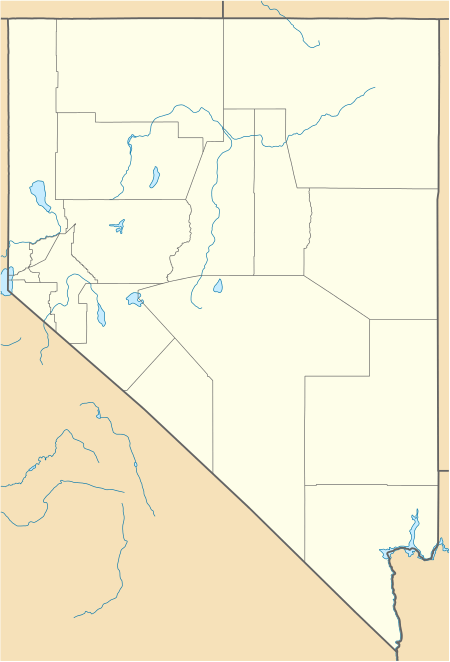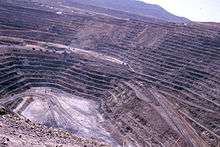Gold mining in Nevada


Gold mining in Nevada, a state of the United States, is a major industry, and one of the largest sources of gold in the world. In 2015 Nevada produced 5,339,659 troy ounces (166.0820 t) of gold worth $6.194 billion, representing 78% of gold produced in the United States and 5.4% of the world's production.[1][2] Total gold production recorded from Nevada from 1835 to 2008 totals 152,000,000 troy ounces (4,700 t), worth over US$228 billion at 2011 prices.[3] Much of the gold in Nevada comes from large open pit mining using heap leaching recovery.
The Nevada mining industry supported an average of 14,196 direct employees in 2015, with about 65,000 additional jobs related to providing goods and services needed by the mining industry. The average pay for mining industry employees during this time was $92,077 per year, second highest of all employment sectors in Nevada.[2]
Major mining companies such as Newmont Mining and Barrick Gold Corporation operate many of the state's gold mines. Active mines include those at Jerritt Canyon and the Carlin Trend.
Although Nevada was known much more for silver in the 19th century, many of the early silver mining districts also produced considerable quantities of gold. The Comstock Lode produced 8,600,000 troy ounces (270 t) of gold through 1959, and the Eureka district produced 1,200,000 troy ounces (37 t). The Robinson copper mine has produced well over 2,700,000 troy ounces (84 t) gold, along with over 4 billion pounds (1,500,000 tonnes) of copper.
Carlin Trend

Gold was discovered in the vicinity of Carlin in Eureka County in the 1870s, but production was small. Placer deposits were discovered in 1907, but the deposits were too small to cause much excitement. It was not until 1961 that the Newmont Mining Corporation found the large low-grade gold deposit at Carlin that the mining industry began to take notice. The Carlin mine began producing gold in 1965, but at the price then of $35 per troy ounce, the ore grade was still too low to cause a rush to northern Nevada. It was not until the gold price shot up in the late 1970s that mining companies rushed to look for similar deposits.[5]
The Carlin Trend, part of what is also known as the Carlin Unconformity, is 5 miles (8 km) wide and 40 miles (60 km) long running northwest-southeast, has since produced more gold than any other mining district in the United States. The trend surpassed 50,000,000 troy ounces (1,600 t) of gold in 2002. The Carlin and other mines along the trend pioneered the method of open-pit mining with cyanide heap leach recovery that is today used at large low-grade gold mines worldwide.
New ore deposits are still being discovered and developed along the trend. The South Arturo deposit was discovered by Barrick Gold in 2005. The deposit contains an estimated 1,300,000 troy ounces (40 t) of gold.[6]
Goldfield
_pose_in_front_of_mine_headframe_(shaft)%2C_Goldfield%2C_Nevada%2C_ca.1905_(CHS-5419).jpg)
Goldfield was discovered in 1902, and began major gold production in 1904. The ore occurs in altered shear zones in Tertiary dacite and andesite. Total gold production through 1959 was 4,200,000 troy ounces (130 t).[7]
Robinson/Ely
The Robinson district at Ely, Nevada produced about 3,000,000 troy ounces (93 t) of gold through 1990, as a byproduct of copper mining.[8]
In 2014 the Robinson Mine produced 86,601,987 pounds of copper, 26,303 troy ounces of gold and 741,717 pounds of molybdenite with 617 employees.[2]
Gold royalties
All mineral and gold production on public and private lands in Nevada is subject to a Net Royalty payable to the State. The gross proceeds from the sale of minerals minus allowable deductions determine the taxable net proceeds. If the net proceeds from sales by a mine in the taxable year total $4 million or more, the tax rate is 5%. For less profitable mines the tax rate is graduated down to 2%. Miners' net proceeds are also subject to federal corporate income tax of 35%.[9][10]
Because the NPM tax is an ad valorem property tax, the amount of the net proceeds times the property tax rate goes to the county where the mineral was extracted. Any additional amount of tax paid up to the 5% goes to the State.[9]
In 2015-2016 the Nevada net proceeds royalty raised $101.6 million (down from $255.6 million in 2012) from gold and silver production, of which the counties received $51.1 million (down from $127 million in 2012).[10][11]
Gold Mining Companies in Nevada

See also
References
- ↑ George, Micheal W. (19 January 2017). "Mineral Commodity Summaries 2017" (pdf). Reston, Virginia: U.S. Geological Survey. p. 73.
- 1 2 3 Perry, Rick; Visher, Mike (1 November 2016). "Major Mines of Nevada 2015" (pdf). Nevada Division of Minerals. Nevada Bureau of Mines and Geology. Retrieved 24 January 2017.
- ↑ Update on Production and Exploration Activity in Nevada - 2009 at Nevada Bureau of Mines and Geology
- ↑ Western Region Gold Deposits at USGS
- ↑ Donald M. Hausen and Paul F. Kerr (1969) Fine gold Occurrence at Carlin, Nevada, in Ore Deposits of the United States, 1933-1968, New York: American Institute of Mining Engineers, p.908-940.
- ↑ Ed Cope and others, "South Arturo: a recent gold discovery on the Carlin Trend," Mining Engineering, Jan. 2008, p.19-25.
- ↑ A.H. Koschmann and M.H. Bergendahl, Principal Gold-Producing Districts of the United States, US Geological Survey, Professional Paper 610, p.177-178.
- ↑ Laurence P. James, 1990, "Gold in the Ely (Robinson) copper district, White Pine County, Nevada," in Gold in Porphyry Copper Systems, US Geological Survey, Bulletin 1857-E, p.E28.
- 1 2 Understanding Nevada’s Net Proceeds of Minerals Tax (PDF). Carson City, NV: Nevada Taxpayers Association. 2008.
- 1 2 "2013-2014 Net Proceeds of Minerals Bulletin" (pdf). Nevada Department of Taxation. Carson City, NV: Division of Local Government Services. 8 July 2014. Retrieved 27 October 2015.
- ↑ "2015-2016 Net Proceeds of Minerals Bulletin" (pdf). Nevada Department of Taxation. Carson City, NV: Division of Local Government Services. 1 June 2016. p. 9. Retrieved 22 October 2016.
External links
- Barrick: Goldstrike Property
- Southern Nevada: The Boomtown Years 1900-1925
- Nevada Mineral Industry 2006, by Nevada Bureau of Mines & Geology
- Major mines of Nevada 2006, by Nevada Bureau of Mines & Geology
- Nevada: A very modern gold rush at Mining Journal, 30 Mar 2012